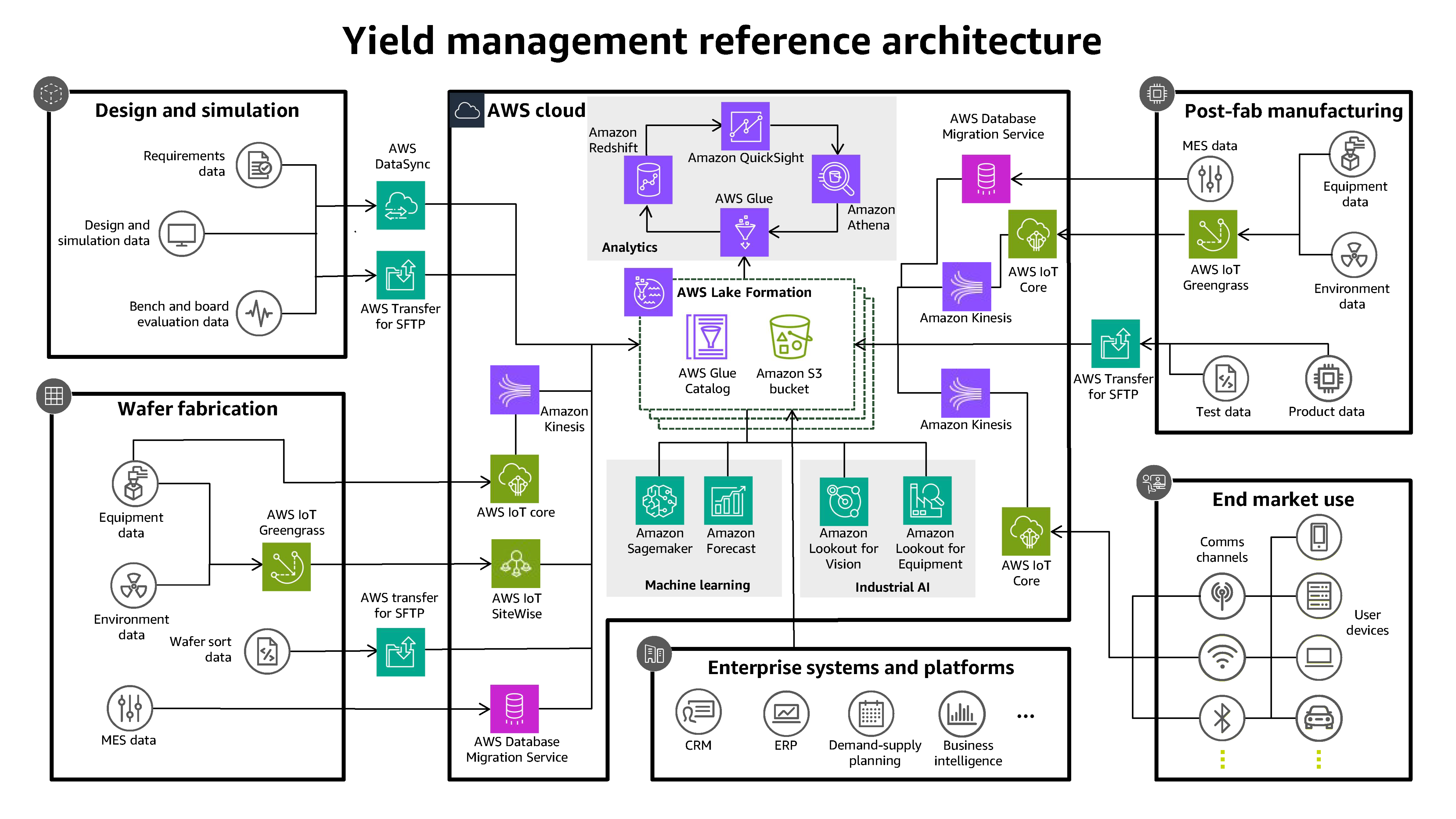Transforming Semiconductor Yield Management with AWS and Deloitte | Amazon Web Services – AWS Blog
Semiconductor yield analysis has evolved over time from simply comparing “good units” vs “bad units” to a deeper dive into data science to understand and mitigate a wide range of contributing factors. While yield-reducing manufacturing defects have been around since the invention of the integrated circuit, today there are other design, process, and market dynamics driving complexities into the yield management function. To address these challenges, a set of advanced yield management capabilities enabled by a modernized data and analytics architecture is needed.
Factors influencing the complexity of yield management today start with the end markets and its users. Original equipment manufacturers (OEMs) and even consumers expect their semiconductor-driven devices to not only be always on and always working, but also to perform strictly to the specification advertised in a variety of environments. In these cases, a ‘bad unit’ may not be discovered on the test floor but in the consumer’s hand.
Failure and defect sources can also be upstream as well as downstream. As integrated circuits (ICs) become more complex, new sources of failure, beyond the factory walls, are introduced. Whether from a tier-two supplier in your complex supply network, or from a new 3D multi-chip package design, the scope of potential defects is continuously widening. With the fast pace of new technology and feature development, as soon as you gain control of quality and yield on one node or IC, the next IC design is released. Yield improvements can also be an effective lever for expanding manufacturing capacity when capital or space is constrained.
This environment presents many challenges for semiconductor companies to achieve a leading yield management capability. The most critical of these challenges are:
To address the challenges above, the following opportunities should be considered:
To realize the opportunities noted in the previous section, new yield management capabilities are needed. The varying levels of yield management maturity across the semiconductor ecosystem notwithstanding, we have learned from our customer and partners that the following six capabilities are critical to building a mature, scalable and reliable yield management system (YMS) for your company
Figure 1: End-to-end semiconductor yield management reference architecture
Together, AWS and Deloitte have developed a reference architecture to enable the aforementioned yield management capabilities. The architecture, shown in Figure 1, depicts how to collect, store, analyze and act on the yield related data throughout the supply chain. The following describes how the modernized yield management architecture enables the six capabilities discussed earlier.
1. End-to-end data source coverage
The semiconductor supply chain is complex and modernizing yield management requires data sharing and collaboration across business units and organizations. The semantics of sharing data across the supply chain is a topic that has been discussed independently here. The architecture enables connections across the manufacturing value chain that includes design and simulation, wafer fabrication, post-fab manufacturing (e.g., assembly, test), and end market use in the field. Data from each stage is valuable in developing the overall strategy to better manage yield for current and future products.
2. Extensive data type handling
Design and simulation data, manufacturing tool IoT data, metrology data, defect image data, electrical test data, spatial data and many other forms of data are generated while manufacturing a chip. These include multiple data types such as structured, unstructured, real-time streaming data, bulk data assets, etc. AWS services such as Amazon Kinesis, AWS IoT Greengrass, AWS DataSync and AWS Transfer Services facilitate ingestion of these different data types near real time or periodically.
3. Scalable data management
Establishing a centralized data repository containing data from various sources is key to enabling the data science and process engineering teams to easily analyze data to uncover root causes and optimize yield. Managing data at this scale and ensuring it is secure, up to date, and in sync can be challenging. AWS Lake Formation allows customers to build, manage, and secure petabyte-size data lakes. Data security can be managed centrally through AWS Lake Formation, and fine-grained access control features – like row-and-cell level access and tag-based access control – make it easier to scale permissions management. A centralized AWS Glue data catalog also helps make all data discoverable.
4. Advanced data processing and analytics
Building a centralized yield management data lake on AWS allows you to use a broad selection of scalable, reliable, cloud-based services that addresses all data analytics needs for managing yield. AWS has the most serverless options for data analytics, which enables you can use these tools with minimal management overhead. AWS Glue can be used to combine various data sources and transform the data. The resulting data set can be stored in an Amazon Redshift data warehouse allowing process engineers to create dashboards and reports using Amazon QuickSight. They can also directly query the data in the data lake using Amazon Athena. Access to these self-service data exploration tools means the data scientists and process engineers can understand the data easily and get to yield improvement outcomes faster.
Machine learning (ML) can play an important role in predicting and improving yield. Amazon SageMaker is a machine learning service that provides fully managed infrastructure, tools and workflows for building, training and deploying machine learning models. It takes care of the undifferentiated heavy lifting so you can concentrate on the business problem. Along with Amazon SageMaker, you can also use industrial artificial intelligence (AI) services such as Amazon Lookout for Vision for anomaly detection using images (e.g., for wafer defect analysis), and Amazon Lookout for Equipment for predictive maintenance on equipment. These AI services do not require any prior ML knowledge which makes it easier and faster to identify issues affecting yield, leading to positive impact on business outcomes. The availability of this large selection of advanced process and analytics tools allows you to choose the right tools for the right job without having to worry about infrastructure configuration or setup, providing your team the broadest toolset to tackle any data challenge.
5. Modernized platform and architecture
A centralized cloud-based yield management platform enables you to easily apply modern DevOps practices to manage data, code, and operations. For example, using Amazon SageMaker MLOps tools, you can easily train, test, troubleshoot, deploy and govern ML models at scale, boosting the productivity of data scientist and ML engineers. AWS services, such as Amazon App Runner and AWS Amplify, make it easier to develop and host web and mobile apps without managing infrastructure. Security and access can also be governed centrally, with several AWS security, identity and compliance tools to make it easier to secure your workloads, applications, and data in the cloud.
6. Enterprise business planning integration
Improving yield is not the only goal of an advanced YMS. A modernized YMS will also influence multiple other business decisions and outcomes over the enterprise. The AWS data lake and analytics services provide the means to connect to your customer relationship management (CRM) system, enterprise resource planning (ERP) system, manufacturing execution system (MES), and other business intelligence systems to inform many processes and stakeholders across the enterprise value stream. For example, yield estimates and predictions can facilitate new sales opportunity pursuit decisions, product cost forecasts, multi-horizon supply and capacity planning, and more.
Relying primarily on product and yield engineers and functional test data to manage yield is no longer sufficient. It’s time to move to a modernized cloud-based YMS that can leverage the compute, storage and security at scale enabling faster and holistic analysis of test, equipment, environment, operations, and other data. This new YMS will “democratize” data to drive efficient yield management by making yield data available to the widest number of users of varying skill sets. It will have the ability to analyze root causes for defects and identify opportunities for yield improvement. Finally, the YMS allows integration with other enterprise platforms and systems to deliver insights across the entire enterprise value stream.
Gautham Unni is the Head of Business Development for Semiconductors Smart Manufacturing. Prior to joining AWS, he had a career in semiconductor manufacturing at GlobalFoundries, Lam Research and Applied Materials in process engineering, product development and product management/marketing roles. He is passionate about improving collaboration and productivity in all manufacturing.
Dan Hamling is a Specialist Leader in Deloitte’s Technology industry group and Supply Chain and Network Operations offering. Dan leverages over 35 years of experience in semiconductors and high-tech to facilitate supply chain and manufacturing transformations at Deloitte’s technology clients. Dan’s focus areas include semiconductor equipment lifecycle management, production planning and scheduling, capacity planning and management, and outsourced manufacturing.
Nishant Saini is a Principal Partner Solutions Architect at AWS for Industrial Software and Semiconductor segment. Nishant works closely with AWS partners acting as a trusted advisor to define, build and evangelize cloud-based solutions for manufacturing and semiconductor industry. He has expertise in industrial automation, industrial data platforms, cybersecurity and supply chain. He is passionate about leveraging technology to advance the state of the manufacturing industry.

